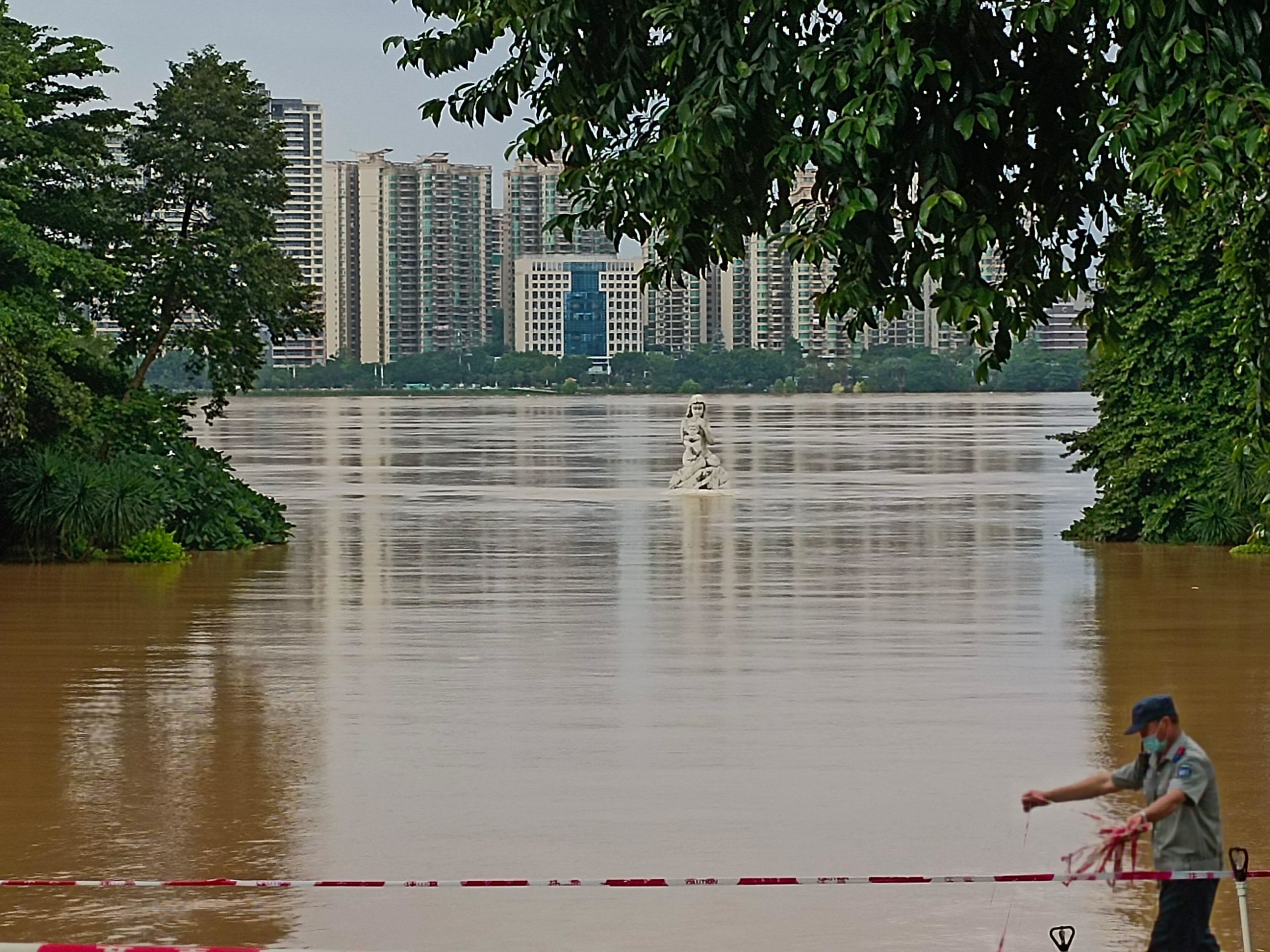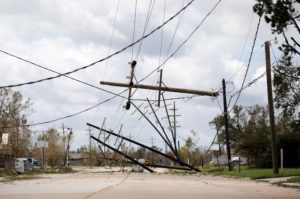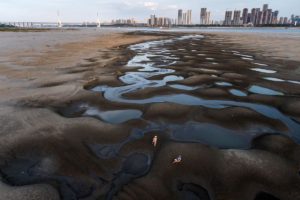Vast swathes of China suffered from unusual weather this summer. Floods, droughts, power shortages, wildfires, heatwaves and heatstroke – the vocabulary of disaster has filled media reports, social networks and daily conversations.
Guangdong experienced a once-in-a-century flood. Towns were inundated and hundreds of thousands of people were affected. Widespread high temperatures and drought caused days of power shortages in Sichuan and Chongqing, with factories shut down to safeguard power supplies for households. In Chongqing, ten wildfires broke out in a single week.
On 7 June, before the summer started, the Ministry of Ecology and Environment and 16 other government departments published a 2035 National Climate Change Adaptation Strategy. This represents the latest guidance on how China will adapt to climate change.
Compared to an earlier version published in 2013, the Strategy gives more thought to adapting China’s social and economic systems, including agriculture, cities and public health. It also considers the ability of sensitive industries to respond to climate change, and the climate resilience of the infrastructure and major engineering projects needed to tackle the current economic slowdown.
A devastating summer
China is a global manufacturing centre, so problems here ripple through supply chains worldwide. As the climate changes, more frequent and extreme weather events will further destabilise supply chains already damaged by the pandemic and war.
On 17 August, the National Climate Centre confirmed that the “regional heatwave incident” that began on 13 June had become the worst since records began in 1961. High temperatures and low rainfall meant the province, which relies on hydropower, suffered widespread power shortages. To ensure household supplies, the government ordered factories to close from mid-August and asked residents to reduce the usage of air conditioners and other power-hungry appliances.
As one media outlet pointed out, Sichuan broke four records over the summer. It recorded the highest temperature, lowest precipitation, lowest river flows, and highest demand for electricity for the time of year.
Sichuan is a key part of the global industrial supply chain for lithium batteries. Emergency power restrictions from 15-30 August worsened an already difficult market. SMM.cn, a metals industry news site, predicted the restrictions would reduce August’s output of lithium carbonate by 1,250 tonnes and of lithium hydroxide by 3,050 tonnes, which respectively represents 4% and 14% of China’s total production of lithium carbonate and lithium hydroxide in August. The restrictions are over but restoring production will take time. Analysis from Huaxi Securities says most firms are focusing on catching up with long-term futures contracts and shortages persist on the spot market. Prices have reflected that: battery-grade lithium carbonate cost 484,000 yuan (US$67.20) per tonne on 12 August, but 503,000 yuan (US$69.85) on 9 September, breaking the psychological price roof of 500,000 yuan that many held before the power shortage.
That is just one aspect of the impact of the heatwave and drought on Chinese manufacturing. In mid- and late June, Guangdong had an entirely different problem: floods.
The province saw record-breaking downpours in early summer. Surging water levels on the Bei River, a tributary of the Pearl, caused a once-in-a-century flood, threatening the manufacturing base of the Pearl Delta downstream. To protect manufacturing cities like Guangzhou and Foshan, the city of Yingde kept its floodgates closed, even as several towns were inundated. Around 400,000 local people were affected.
Adapting industry to a changing climate
The reality of the climate crisis is there to see. So how do we minimise losses?
Part of the answer lies in a more effective warning system. The government Strategy’s main targets include improving China’s ability to monitor and warn of climate change and extreme weather by developing big data and artificial intelligence forecasting tools, and making sensitive industries better respond to extreme weather events and their consequences.
“I think it’s vital to use real-time satellite monitoring, big data and AI to manage climate risks and create early warning capacity. And China is able to do that,” Hu Xi, a program fellow with Harvard University’s Labour and Worklife Program who studies the impact of the climate on labour, told China Dialogue.
Meanwhile, firms toward the lower end of the industrial chain should expand and diversify their supply chains rather than put all their eggs in one basket, said Hu. “Damage caused by extreme weather could mean your current supplier of raw materials can supply you no longer. You have to diversify supply chains to reduce that risk,” Hu added. “Overseas, there are supply chain data firms which can provide early warnings of supply chain issues. Maybe there’s been a flood somewhere, and that’s affected one of your supplier’s suppliers. You can get live updates on that situation and respond in good time.”
Liu Chunsheng, associate professor at the Central University of Finance and Economics, said in an interview with Economic View that listed companies vulnerable to extreme weather should set up appropriate risk warning and management systems. That would include disclosing the risks and impacts affecting their facilities, supply chain and logistics. Liu said that climate risks and response plans should be part of a company’s day-to-day business.
The Sichuan drought has highlighted extreme weather vulnerabilities in China’s electricity systems as well as its supply chains. The Strategy includes a section on sensitive secondary and tertiary industries that stresses: improved climate resilience for the energy sector; stronger protection and emergency response for power transmission and distribution grids; and enhanced risk monitoring, warning, prevention, response and rapid recovery systems for power infrastructure. There has already been debate in the media and beyond about how to ensure a stable power supply.
One approach is to speed up the deployment of new energy sources, such as wind and solar, including on a distributed basis, so different forms of energy can substitute for each other when needed. Others include upgrading power grids so they can better transmit power in both directions, which would improve emergency cross-provincial power supply; and encouraging the use of gas-fired power generation to ensure stable supplies. It remains to be seen what measures will be taken.
Making infrastructure more resilient
The pandemic, a property crisis and extreme weather events are putting the Chinese economy under pressure. The government hopes to use infrastructure investment to stimulate economic growth, which in the first half of the year was only 2.5%. But investment in infrastructure beat that, growing 7.4% from January to July, with an increase in the monthly growth rate for three consecutive months from May.
Meanwhile, increasingly frequent extreme weather events are a new threat to transportation and other infrastructure. According to joint research by Beijing Normal University and the Chinese Academy of Sciences’ Institute of Atmospheric Physics, heavy downpours caused by global warming make it more likely that railway lines will be affected by floods and landslides. That could cost China’s railways up to US$3.53 billion a year if the world were to warm by an average of 3C.
Everyone in China is taking climate change very seriously now. Every sector, every department is thinking about climate adaptation.Chao Qingchen, director of the National Climate Centre
There is an urgent need to reduce climate risks in infrastructure investment. The government’s Strategy calls for changes to technical standards relating to infrastructure and major engineering projects to improve climate resilience. Planning and preliminary studies for future adjustments will be made, taking into account mid- and long-term climate trends, the Strategy states.
There are precedents for this approach. The government of South Africa carried out a climate risk assessment when planning to expand the Durban harbour. The design of the port was strengthened to account for higher sea levels and stronger storms, and an emergency response plan was drafted.
“I think there are two aspects to boosting climate resilience for infrastructure,” said Hu Xi. “First, apply climate models to local infrastructure building. Every site has its own climate and that means we need very granular data on climate risks. Second, understand the weaknesses of new infrastructure and apply tougher standards.”
This will inevitably increase costs. Persuading investors to cough up the extra is a headache worldwide.
“Why is there such a failure to assess the economic costs of climate change on infrastructure? Because nobody understands the benefit of building to higher standards, what the economic value is,” says Hu Xi. “That’s why so few people are doing climate adaptation.”
One of the few pieces of research into the return on better climate resilience in infrastructure is “Accelerating Climate-Resilient Infrastructure Investment in China”, a paper produced by the World Resources Institute, with China’s National Centre for Climate Change Strategy and International Cooperation, and the International Institute of Green Finance at Beijing’s Central University of Finance and Economics.
After carrying out case studies of water-saving irrigation facilities in Ningxia, sponge city construction in Wuhan, and sea dike construction in Shenzhen, the researchers concluded that every yuan invested in climate resilience would return two to twenty times as much in value over the next 30 years. This value would take the form of avoided losses (from drought, urban flooding and storm tides), economic benefits, and social and environmental benefits, such as reduced pollution and a more stable climate.
The report pointed out that China is facing a serious funding gap for climate-resilient infrastructure. An annual average of almost 500 billion yuan (US$69 billion) extra is needed for the next five years, the researchers calculated.
The director of the National Climate Centre, Chao Qingchen, told China Dialogue: “Everyone in China is taking climate change very seriously now. Every sector, every department is thinking about climate adaptation. At the policy level, we’re talking about using financial levers to steer investments in a greener and more climate-resilient direction. But I don’t think we’ve actually implemented many of those measures.”
Alongside the lack of funds, there is a failure to assess climate feasibility for infrastructure projects. Such assessments would involve an analysis of the climate suitability and risks of any zoning or construction plans that could be particularly affected by climatic conditions, and of the impact on the local climate.
“Take the Tibet–Sichuan high-speed railway, currently being built,” says Chao Qingchen. “A solid assessment of climate risks along the route was required at the design stage before building started. We were involved in that process, but a lack of data from the area meant the assessment wasn’t detailed enough. And many assessments refer to past meteorological data when the future climate can’t be linearly extrapolated from the past. That means assessments of future risks aren’t particularly accurate. We need to use climate modelling to assess future risks. The findings might be uncertain, but would provide a point of reference.”

Some countries are trialling the use of climate models in infrastructure planning. Hu Xi told China Dialogue: “The UK and other countries require project builders to carry out climate scenario modelling, and many resilience tests need to be done before building starts. I think that’s a practice China could adopt.”
Chao Qingchen thinks meteorologists should be more closely involved while a project is being built and run.
“There are a lot of culverts on the Tibet–Sichuan line. There should be meteorological stations built at those sites while the line is being constructed. Data gathered during that process can be used to adjust the materials chosen and adapt to potential future risks. But as I understand it, there is still room for better cooperation and data sharing between the constructors and the meteorological authorities.”
Also, better cooperation would help evaluate the ecological impact of large projects and the risks faced as climate conditions change.
“Overall, I think infrastructure projects need better assessment and analysis of climate risks and environmental factors in the design stage, during construction, and while operating,” said Chao Qingchen.









